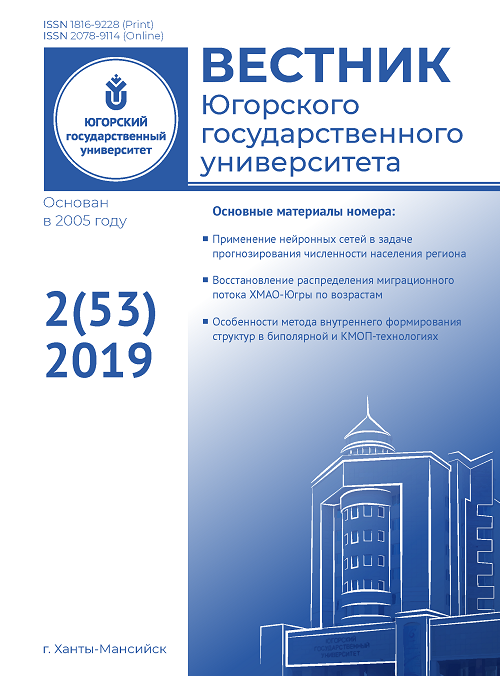Vol 15, No 2 (2019)
- Year: 2019
- Articles: 6
- URL: https://vestnikugrasu.org/byusu/issue/view/1114
Math modeling
Virtual assistance information model for public services
Abstract
Currently, the world and Russia are rapidly developing the direction of developing virtual assistants. This is primarily due to the demands of business, the state and the population for this product, as well as the development of technologies capable of high-quality implementation of this product. Offers on virtual assistants for business and the public exist in large numbers: Google Assistant, Microsoft Cortana, Siri, etc. At the same time, there are no ready-made solutions for state needs in the market. The task of navigating public services today is the most relevant and relevant for the public sector. Solving this problem using a virtual assistant will save billions of rubles a year across the country. The article proposes an information model for the implementation of a virtual assistant for navigating public services. The basis of the intelligence of the developed virtual assistant is made up of artificial neural networks. The developed virtual assistant information model is implemented in the VIka software product. The trial operation of VIka takes place on the website of the administration of the Khanty-Mansiysk Autonomous Okrug – Yugra, located at https://vi.admhmao.ru/chat/new.php. To date, VIka can help navigate services in 10 areas, such as healthcare, utilities, a line to kindergarten, etc.
 7-15
7-15


The usage of a neural networks for forecasting population a region
Abstract
This article describes the use of a neural network, namely, a multi-layer perceptron in the problem of forecasting the population of the region on the example of the Khanty-Mansiysk Autonomous Okrug-Ugra. In solving this problem, we used data on the population of KHMAO-Yugra for the period from 1989 to 2018, on the basis of which the forecast of the population of KHMAO-Yugra for 2019–2029 was made. Based on the results of forecasting, conclusions are made about the applicability of neural networks in the forecasting problem.
 16-22
16-22


Design of physical access control system with integrated wireless authentication
Abstract
This article discusses the design of a physical access control system for an enterprise with various methods of authentication and user identification. A review of existing solutions in the design of physical access control systems was conducted. In the course of the work, a system design was proposed, and its components were described in detail.
 23-28
23-28


Restoring the distribution of the migration flow of the Khanty-Mansiysk Autonomous Okrug – Ugra by age
Abstract
Restoring the distribution of the region's migration flow is part of the task of forecasting the region's personnel potential, which is an important task in drawing up programs for the social and economic development of the constituent entities of the Russian Federation. The relevance of the task of restoring the distribution of the migration flow of the region is due to the fact that today there is no exact data on the age distribution of migrants entering or leaving the region. The article describes the approach to restoring the distribution of migration flow by age using the example of the Khanty-Mansiysk Autonomous okrug – Yugra. The purpose of the present study is to determine the numerical characteristics – the vector of the distribution coefficients of the migration flow by age for the Khanty-Mansiysk Autonomous Okrug-Yugra in 2010. The study was conducted on the basis of data from statistical collections of the Russian Federal State Statistics Service. The main results of the study are to obtain the distribution coefficients of migration by age for the Khanty- Mansiysk Autonomous Okrug – Yugra.
 29-32
29-32


Automation of compilation of working programs of educational disciplines
Abstract
The article describes the automation of the process of compiling work programs for academic disciplines by teachers of Yugra State University. When drawing up a work program, the teaching staff fills in the document manually in accordance with the curriculum, while there is always a risk of incorrect filling, errors and other shortcomings. Automation of work programs will allow you to fill in most of the dynamically changing fields automatically, while the program will check the correct filling of data, such as the distribution of hours of work from the curriculum for the selected discipline. To automate the described process, it was decided to develop a web application. The authors provide an overview of analogues. A study of the process of compiling work programs. A list of fields to be automated has been defined. A study of the database of Yugra State University. The description of the technologies and languages used in the development of the web application is given.
 33-40
33-40


New materials and technology
Peculiarities of the method in internal formation of structures in bipolar and CMOS technologies
Abstract
The possibility of creating silicon bipolar high-power microwave transistors by the method of ion doping of monosilicon with B + ions through a layer of SiO2 and emitter windows in it with the subsequent introduction of P + ions into them and annealing in argon is shown. The developed process reduces the labor intensity of manufacturing and improves the frequency and power characteristics of transistors: increasing the cut-off frequency (collector current = 1.5 A) from 1.8 to 2.1 GHz and from 1.5 to 1.9 GHz (collector current = 2,8 A), output power from 20 to 21.3 W, power gain from 2.5 to 2.7, collector efficiency from 60 to 79.8 %. The formation of pockets of n- and p- type CMOS structures was considered using a mask of thermal SiO2 without a layer of Si3N4. The developed process reduces the labor intensity of manufacturing by ~ 21.5 % and increases the yield of CMOS microcircuit structures by ~ 4.5 %, thanks to a decrease in the residual stresses in monosilicon and the improvement of pocket doping methods.
 44-61
44-61











